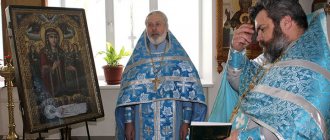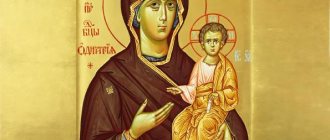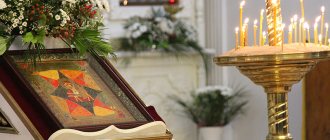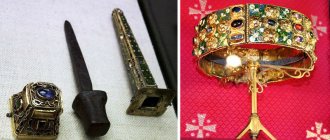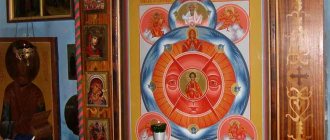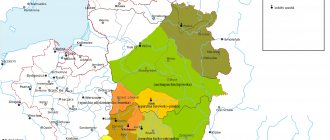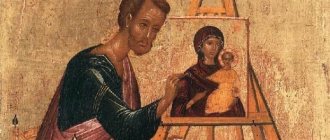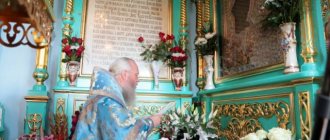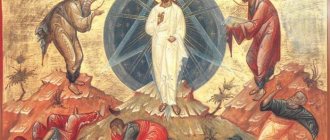Icon of the Mother of God “Watching Eye”
In the city of Rybinsk, in a monastery chapel located near the Rybinsk-Bologovskaya railway station, there is an ancient miraculous icon called the “Waking Eye”. It was donated by the daughter of the famous preacher, Archpriest Rodion Putyatin, who had a special reverence for this icon due to family traditions. The image is 10 inches wide and one arshin high; it is written on canvas glued to a wooden board; His painting belongs to the Italian style. The Blessed Virgin is depicted at half height; She sits in front of a table in a room with a dark green curtain selected on the left side. Her head is covered with a white veil, from under which her hair is visible. Her most pure face and sad gaze are lowered down and turned to the lying Infant of God. The left hand of the Mother of God, resting on the table, supports Her head, and the right hand of the sleeping Infant of God. The eyes of the Eternal Child are closed, and His head is turned to the right; the right hand rests on the right hand of the Mother of God, and the left on the bent knee of His left leg; The middle part of the body is covered with white taffeta. At the bottom of the icon is the following inscription: “I sleep, but My heart watches” (Song. 5:2). This inscription testifies that the name of the icon “Watching Eye” has a symbolic meaning: it indicates that the Savior and His Most Pure Mother are always vigilantly concerned about our salvation.
Another icon with the same name is located in the city of Uglich, Yaroslavl province, in the Epiphany Chapel of the Epiphany Monastery, built It was donated in 1848 by a resident of Uglich, A.V. Lebedeva, who certified that this icon is very ancient and has long been considered miraculous. The icon is more than an arshin in height and 3/4 of an arshin in width and is painted on a board in Italian painting. The Virgin Mary is depicted sitting in a room with a window on the right side. Her head is turned to the left and is covered up to the shoulders with a blue veil, from under which her hair comes out. The eyes of the Mother of God are half-open and turned to the sleeping Eternal Child. Her outer robe is blue and her lower robe is scarlet. The sleeping Infant of God rests on the left knee and left hand of the Mother of God; His head is turned to the left; arms folded under the chest, and legs bent at the knees and lowered down. His entire body is dressed in a white shirt and placed on an unfolded white shroud, one edge of which is raised by the right hand of the Mother of God to the level of Her right shoulder. The icon is decorated with a gilded chasuble and crowns. Other decorations on this icon - three silver images of feet and two silver crosses - were donated by persons who were healed after praying in front of this icon. Before this icon, as well as before the first, the following prayer to the Mother of God is read: “Oh, Most Precious Lady, Lady Theotokos! Receive us who fall into Your image; look with Your ever-watchful eye on our sinful spiritual ulcers; pray with your heart to Your Son, Christ our God, who watches over us, that He may deliver us with faith in Him who resort to the heavy sleep of sin and from all the slander of the enemy, that He may save our souls, as a Lover of mankind.”
In the city of Rybinsk, in a monastery chapel located near the Rybinsk-Bologovskaya railway station, there is an ancient miraculous icon called the “Waking Eye”. It was donated by the daughter of the famous preacher, Archpriest Rodion Putyatin, who had a special reverence for this icon due to family traditions. The image is 10 inches wide and one arshin high; it is written on canvas glued to a wooden board; His painting belongs to the Italian style. The Blessed Virgin is depicted at half height; She sits in front of a table in a room with a dark green curtain selected on the left side. Her head is covered with a white veil, from under which her hair is visible. Her most pure face and sad gaze are lowered down and turned to the lying Infant of God. The left hand of the Mother of God, resting on the table, supports Her head, and the right hand of the sleeping Infant of God. The eyes of the Eternal Child are closed, and His head is turned to the right; the right hand rests on the right hand of the Mother of God, and the left on the bent knee of His left leg; The middle part of the body is covered with white taffeta. At the bottom of the icon is the following inscription: “I sleep, but My heart watches” (Song. 5:2). This inscription testifies that the name of the icon “Watching Eye” has a symbolic meaning: it indicates that the Savior and His Most Pure Mother are always vigilantly concerned about our salvation.
Another icon with the same name is located in the city of Uglich, Yaroslavl province, in the Epiphany Chapel of the Epiphany Monastery, built under the cathedral monastery church. It was donated in 1848 by a resident of Uglich, A.V. Lebedeva, who certified that this icon is very ancient and has long been considered miraculous. The icon is more than an arshin in height and 3/4 of an arshin in width and is painted on a board in Italian painting. The Virgin Mary is depicted sitting in a room with a window on the right side. Her head is turned to the left and is covered up to the shoulders with a blue veil, from under which her hair comes out. The eyes of the Mother of God are half-open and turned to the sleeping Eternal Child. Her outer robe is blue and her lower robe is scarlet. The sleeping Infant of God rests on the left knee and left hand of the Mother of God; His head is turned to the left; arms folded under the chest, and legs bent at the knees and lowered down. His entire body is dressed in a white shirt and placed on an unfolded white shroud, one edge of which is raised by the right hand of the Mother of God to the level of Her right shoulder. The icon is decorated with a gilded chasuble and crowns. Other decorations on this icon - three silver images of feet and two silver crosses - were donated by persons who were healed after praying in front of this icon. Before this icon, as well as before the first, the following prayer to the Mother of God is read: “Oh, Most Precious Lady, Lady Theotokos! Receive us who fall into Your image; look with Your ever-watchful eye on our sinful spiritual ulcers; pray with your heart to Your Son, Christ our God, who watches over us, that He may deliver us with faith in Him who resort to the heavy sleep of sin and from all the slander of the enemy, that He may save our souls, as a Lover of mankind.”
LiveInternetLiveInternet
Sunday, February 03, 2013 18:46 + in quotation book The icon has a symbolic meaning; and the words: “I sleep, but my heart watches,” from the Song of Songs of the Biblical King Solomon (Song of Songs: 5, 2) mean not only the All-Seeing and, therefore, the Never-Slumbering Eye of God, but also indicate the future resurrection of Christ from the dead, when the sleep of death could not fetter Eternal Life. Although Christ reclined in the tomb and was buried, he rose from the dead on the third day. And how God could not die, but descended into hell with His immortal soul, giving light and liberation to the prisoners of death, and according to His Divinity, His eyes never closed in the sleep of death. That’s why the iconography is called exactly that: “The Sleepless Eye.” In Greek, the iconography is otherwise called “Anapeson” or reclining, which also allegorically speaks of the resurrection of Christ; The lion of Judah reclining regally, as if sleeping... If we remember the prophecy of Jacob, which he taught to his sons: “The young lion Judah, my son, rises from the spoil. He bowed down and lay down like a lion and like a lioness; who will lift it? ...washes his clothes in wine and his garments in the blood of grapes (the vine - my note). (Gen. 9:10-11). Symbolically, the lion is the king of beasts, which indicates the Royal origin of Christ from the line of David, the lion’s reclining is the dream of Christ’s death, the washing of clothes in wine as in blood is death and suffering and the offering of Himself as a Sacrifice for the sins of the world, as happened on Calvary; and this prototype also hides the Eucharistic meaning, as always when wine and blood are compared in Holy Scripture. "Who will lift it?" - none of the people, which implies the Divine dignity of Christ. Therefore, the icons “Christ Anapeson” or “Wakeful Eye” symbolically or in hidden images refer us to the death and resurrection of Christ, and thereby testify to His Divine love for the Church of the faithful, about the reciprocal love of the Church for His Bridegroom. “I sleep, but my heart (My love for you) watches,” that is, it never stops. Origin of iconography. Byzantine icons of the Mother of God holding the reclining God-infant Christ in her arms were inscribed “Anapeson”, namely “reclining”; the name itself prophetically reflects the death and mourning of Christ, the three-day reclining of His most pure flesh in the tomb. Remembering the prayer of the Eucharist: “Thou art the offering, and Thou art the offered,” - Prostrated in the arms of His Most Holy Mother, He died and rose again, becoming the Heavenly Bread, feeding the faithful into eternal life. Therefore, the Mother of God is the mysterious Divine Table, the Holy Eucharistic Throne, on which the Holy Gifts of the Body and Blood of Christ are offered and consecrated. On top of the maphoria of the Virgin is a scarlet cloth, indicating this analogy or supernatural reality. The scarlet cloth or cover of the Eucharistic Throne, where the Sacrament of the Sacraments is celebrated, is sometimes depicted on top of the mother of God and is often embroidered with gold or a gold border with precious stones and pearls.
Byzantine iconography "Anapeson" knew not only icons of the Mother of God, sometimes the Infant of God Himself was depicted, reclining on a scarlet bed. Scarlet color also means Resurrection. Such images are often found in temple paintings, these are mosaics and frescoes.
Sometimes, the Mother of God prayerfully stands before the reclining Christ, and on the other side there is an Angel with a ripida or fan, reverently protecting the sleep of Christ, fanning and thus comforting Divine sorrow. The inscription, “... asleep like a lion,” refers us to the prophecy of Patriarch Jacob.
More complex compositions are also presented. The Most Pure Mother of God, reclining on the bed, embraces and consoles the Infant God. On the left are angels with ripida and instruments of the passions, and on the right is Patriarch Jacob with an unrolled scroll of his prophecy.
Byzantine miniature preserved on Mount Athos. The Infant Christ is depicted as a youth and as the Bridegroom of the Church in bright vestments; Christ and Mary the Mother of God both recline on green grass strewn with flowers, symbolically pointing to Paradise. Christ is full of sorrow, He turns His gaze to the Mother, Who embraces Him.
Already on ancient Russian icons the theme of Paradise dominates; the Tree of Life, scarlet birds of paradise and a scroll of the sky at the top of the icon with stars are depicted. Everything speaks of the Garden of Eden in the bright Heavenly Dwelling of God. Pskov icon of the 16th century.
There is a dialogue between Christ and the Mother of God, which is recorded on scrolls unfolded in Their hands. Angels surround the Divine bed with a candle and instruments of the passions or with a ripida and a Cross. Most likely, one of them is Archangel Michael, the leader of the heavenly army; this is indicated by his larger size compared to the other angel. Moscow. mid-16th century
All ancient Russian icons are written on white, symbolically WHITE COLOR has the same meaning as the primordial light, it is also the Light of Life, and the Divine uncreated radiance, and the Heavenly Dwelling, and the Paradise of spiritual sweetness, the coming Glory of the Future Age, Easter, Resurrection and immortality. The Mother of God turns to Christ in prayer with sadness, love and hope. Comforting His Mother, the Son of God answers Her request with the words of Solomon: “I sleep, but My heart is watchful.” (Song of Songs: 5, 2) These words can be translated as follows: although I must die as a man in order to redeem and save the sinful race of Adam, but as God I am always alive, therefore, “I will rise again and exalt with glory, like God, by faith and the love of You who magnify." Glorifying You, My Mother, as the Mother of God. Therefore, it is known that in ancient Russian icon painting from the 16th century this iconography received the name “Wakeful Eye”.
The iconography of the Sleepless Eye also serves as a visible image of the service of commemoration of Good Friday, when the canon of St. Simeon Metaphrast, which describes the Lamentation of the Virgin Mary, is read in the Church. Images of the Mother of God related to the iconography of Anapeson.
Series of messages “Theory of the image (Orthodox icon)”:
Part 1 - Votive icons. St. John the Baptist of the Lord Kykkos Museum. Cyprus 12th century. Part 2 - Prot. Nikolai Chernyshev. Very important article! Part 3 - “Christ Anapeson” or “The Sleepless Eye” Part 4 - Medieval surrealism, its origins in the West. Part 5 - Pieta and the iconography of the passions. Part 6 - Iconography of the image: Christ in prison; Spas is half-night; Behold, the Bridegroom (“King of the Jews”; Ecce Homo - “Behold, a man”; Virum Dolorum - “Man of Sorrows”) Part 7 - Aaron or Melchizedek.
Cited 1 time
Like share
0
Like
- I liked the post
- Quoted
- 0
Saved
- Add to quote book
- 0
Save to links
Liked
0
Orthodox prayer - Orthodox book
Icon of the Mother of God “Watching Eye”
“In the city of Rybinsk, in the monastery chapel, built near the Rybinsk-Bologovskaya railway station, there is an ancient miraculous icon donated by the daughter of the once famous preacher Rodion Putyatin. This icon is called the “Watching Eye”, has 1 arshin in height and 10 arshins in width, painted on canvas glued to a wooden board, the painting on it is in the Italian style. The Mother of God is depicted at half height, sitting before a table in a room with a dark green curtain selected on the left side. Her head is covered with a white veil, from under which her hair is visible. Her most pure face is sad, with eyes downcast, turned to the lying Infant of God. The outer clothing of the Mother of God is brown-pink, and the lower one, the chiton, is light blue; Her left hand, resting on the table, supports Her head, and her right hand supports the sleeping Infant of God on a light crimson pillow. His head is turned to the right side, His eyes are closed; His right hand rests on the right hand of the Mother of God, and his left on the bent knee of His left leg; The middle part of the body is covered with white taffeta. At the bottom of the image is the caption: “I sleep, but my heart watches” (Song of Songs, chapter 5, art. 2). Another icon of the Mother of God, the Never-Slumbering Eye, is located in Uglich, in the Epiphany Chapel of the Epiphany Monastery, built under the cathedral monastery church. It was donated in 1848 by the elderly widow A.V. Lebedeva, a resident of Uglich, who certified that from ancient times this icon, according to legend, was revered as miraculous. The icon is 1 arshin with 1 inch in height and ¾ arshin in width, painted on a board, Italian painting. The Mother of God is depicted up to her knees, sitting in a room with a window on the right side and a curtain on the left. Her head, tilted to the left, is covered up to the shoulders with a blue veil, from under which hair comes out. The eyes of the Mother of God are half-open and turned to the sleeping Infant God. The lower robe is scarlet and the upper robe is blue. On the left knee and on the left hand of the Mother of God rests the sleeping Divine Infant, whose head is turned to the left; arms folded under the chest, and legs bent at the knees, right to left, and lowered down. His whole body is dressed in a white shirt and placed on an unfolded white shroud (plate), one edge of which is raised by the right hand of the Mother of God to the level of Her right shoulder. The image contains a silver gilded chasuble and crowns; in addition there are 2 silver crosses and 3 silver images of feet, and were donated from healed persons who ran with prayer to the Mother of God in front of this image. The celebration of the image of the Never-Slumbering Eye takes place on May 29 [old style]” (Earthly Life of the Most Holy Theotokos / Compiled by S. Snessorev. - Yaroslavl: Nord, 2005, pp. 172–173).
Orthodox book by mail pravmolitva.ru
